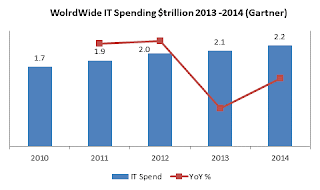Worldwide IT spending
is projected to total $3.7 trillion in 2013 including Telecom Services, a 2
percent increase from 2012 spending of $3.6 trillion, which is half of what
Gartner forecasted earlier at the beginning of 2013 in first quarter in U.S.
dollars was 4.1 percent. The 2.1 percentage point reduction was forced due to
the recent fluctuations in U.S. dollar exchange rates; growth in constant
currency is forecast at 3.5 percent for 2013, down only slightly from last
quarter. With the Indian rupee falling to record lows, from Rs 54 at the
beginning of 2013, it touched Rs 60 against the US dollar Indian companies have
reduce their IT budgets as most of the Software, Hardware and Services are
imported and are paid for in US dollars. Most of the emerging market currencies
have depreciated significantly against dollar which forced Gartner to reduce
the IT spending for 2013. Excluding the Telecom services the Global IT Spending
is estimated to reach $ 2.068 trillion in 2013 and $ 2.181 trillion in 2014.
Apart from the currency fluctuations, the big decline in the forecasting of
devices led to significant fall in growth and the forecast for spending on
devices in 2013 has been revised down from 7.9 percent growth in Gartner's
previous forecast to 2.8 percent.
 Within
the devices segment majority of the decline is in PC sales, which was
highlighted both in the first quarter and second quarters of 2013, with little recovery
expected during the second half of 2013. Personal computer sales is hit hard by
both the Tablets and the smartphones both at the high end and mid end and both
tablets and smartphones are offering equivalent computing power that is offered
by a laptop or desktop and customers are using these mobile devices more to
browse internet, access email and Social networking sites through mobile
devices. While new personal computers particularly laptops that are sleek in
design and with touch screen capabilities are expected to be launched in the
second half of 2013, they will fail to gain market share due to the underlying
weakness of the traditional PC market.
Within
the devices segment majority of the decline is in PC sales, which was
highlighted both in the first quarter and second quarters of 2013, with little recovery
expected during the second half of 2013. Personal computer sales is hit hard by
both the Tablets and the smartphones both at the high end and mid end and both
tablets and smartphones are offering equivalent computing power that is offered
by a laptop or desktop and customers are using these mobile devices more to
browse internet, access email and Social networking sites through mobile
devices. While new personal computers particularly laptops that are sleek in
design and with touch screen capabilities are expected to be launched in the
second half of 2013, they will fail to gain market share due to the underlying
weakness of the traditional PC market.
Tablets and Smartphones
are expected to keep up the growth rates as highlighted by the outlook for
tablet revenue for 2013 is 38.9 percent growth, while mobile phone revenue is
projected to increase by 9.3 percent. Enterprise
software spending is on pace to grow 6.4 percent in 2013 within which growth forecast
for customer relationship management (CRM) have been raised as its adoption expanded
coverage into e-commerce, social and mobile. Expectations for digital content
creation and operating systems have been reduced as software as a service
(SaaS) and changing device demands impact traditional models and markets.
Overall both the macroeconomic volatility and changes in the technology trends
are impacting the IT spend in 2013 and expected to have significant impact in
2014 too.